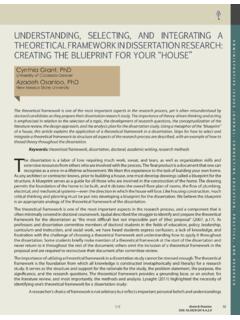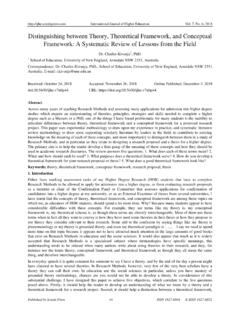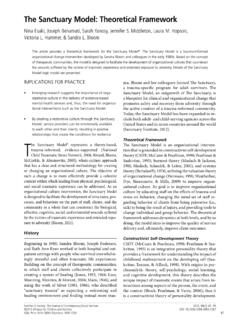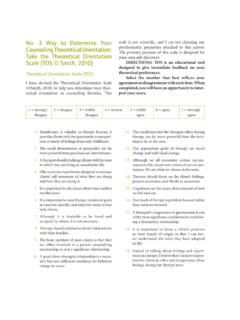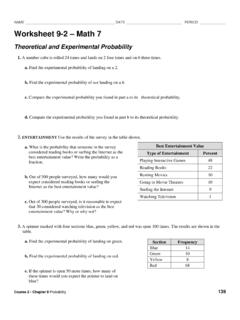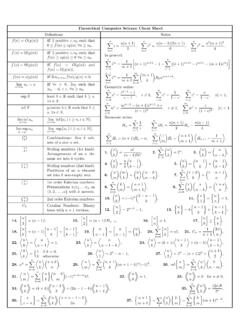Transcription of Qualitative Content Analysis
1 Content Analysis : theoretical foundation,basic procedures and software solutionMayring, PhilippErstver ffentlichung / Primary PublicationMonographie / monographEmpfohlene Zitierung / Suggested Citation:Mayring, P. (2014). Qualitative Content Analysis : theoretical foundation, basic procedures and software :nbn:de:0168-ssoar-395173 Nutzungsbedingungen:Dieser Text wird unter einer CC BY-NC-ND Lizenz(Namensnennung-Nicht-kommerziell-K eine Bearbeitung) zurVerf gung gestellt. N here Ausk nfte zu den CC-Lizenzen findenSie hier: of use:This document is made available under a CC BY-NC-ND Licence(Attribution-Non Comercial-NoDerivatives). For more Informationsee: Qualitative Content Analysis theoretical Foundation, Basic Procedures and Software Solution Philipp Mayring Philipp Mayring: Qualitative Content Analysis . theoretical Foundation, Basic Procedures and Software Solution Klagenfurt, Austria, 2014 free download pdf-version for print on demand see copyright Philipp Mayring 4 Table of Contents 1.
2 Introduction: Research Methods Between Qualitative and Quantitative Paradigms .. 6 Science War: Conflicting Paradigms .. 6 Mixed Methods as a Solution? .. 8 Common Research Criteria for Qualitative and Quantitative Approaches .. 9 Qualitative Content Analysis as Mixed Methods Approach, Following Common Research Standards .. 10 Basic Research Steps .. 10 2. Overview on Approaches to Text Analysis in Social Sciences .. 16 3. theoretical Background for a Qualitative Content Analysis .. 18 Communication Science: Quantitative Content Analysis .. 18 Preliminary Phase .. 18 Consolidation Phase .. 19 Fine Developments and Interdisciplinary Expansion .. 19 The Present-day Situation: Discontent Analysis ? .. 20 Basic Techniques of Quantitative Content Analyses .. 22 Human Sciences: Hermeneutics .. 27 Linguistics: The Structure of Language and Text .. 31 Psychology of Text Processing .. 34 General Psychology: Theories of Categorization.
3 37 4. Basics of Qualitative Content Analysis .. 39 Basic Principles and Definition .. 39 Embedding of the material within the communicative context .. 39 Systematic, rule-bound procedure .. 39 Categories in the focus of Analysis .. 40 Object reference in place of formal techniques .. 40 Testing specific instruments via pilot studies .. 41 Theory-guided character of the Analysis .. 41 Integrating quantitative steps of Analysis .. 41 Quality criteria .. 42 Materials for Qualitative Content Analysis What Could be Analyzed? .. 43 Transcription Systems .. 45 Content -Analytical Context Model .. 48 Content -Analytical Units .. 51 A General Step-by-step Model of Qualitative Content Analysis .. 53 5. 55 Presentation of the Corpus Material .. 55 Defining the Text Material .. 56 Determining the Material .. 56 Analysis of the Circumstances of Origin .. 57 Formal Characteristics of the Material.
4 57 Direction of Analysis .. 58 Theory-oriented Differentiation of the Problem .. 59 theoretical Differentiation of Sub-issues .. 59 6. Specific Techniques of Qualitative Content Analysis .. 63 Basic Forms of Interpretation .. 63 Summarizing .. 65 Inductive Category Formation .. 79 Explication (Context Analysis ) .. 88 Structuring Deductive Category Assignment .. 95 Mixed Procedures .. 104 5 Content Structuring / Theme Analysis .. 104 Type-building Content Analysis .. 105 Parallel procedures .. 106 7. Quality Criteria of Content Analysis .. 107 Classical Quality Criteria .. 107 Specific Content -analytical Quality Criteria .. 109 Three Levels of Inter-coder Agreement .. 114 8. Computer Programs for Qualitative Content Analysis .. 116 9. Related text Analysis 123 125 References .. 136 6 1. Introduction: Research Methods Between Qualitative and Quantitative Paradigms This introduction criticizes the methodological dichotomization of Qualitative and quantitative research, defines Qualitative Content Analysis as a mixed methods approach (containing Qualitative and quantitative steps of Analysis ) and advocates common research criteria for Qualitative and quantitative research.
5 Finally, a step-by-step model of the ( Qualitative -quantitative) research process is presented. Perhaps, no issue in social sciences contains more differences of opinion than research methodology. And there is perhaps no topic with more importance for scientific work and valid research results than that of adequate research methods. The disagreement about methods between different social science disciplines becomes evident in different forms: In sociology, an interpretive field study orientated tradition and a quantitative survey oriented tradition coexist. In psychology, quantitative experiments for causal inferences are within mainstream whereas Qualitative approaches only occur recently. In economics, case studies were predominant at the time when quantitative economics rose. This plurality makes it difficult to establish criteria for evaluation or to design curricula for teaching research methods (Packer, 2011, p.)
6 2). More and more, method preferences seem to be individual and arbitrary decisions of researchers. Science War: Conflicting Paradigms In 1959, Snow diagnosed two cultures in sciences, working with different methods: a constructivist, postmodern position and a realistic position (Snow, 1959). In the nineties, after a parody on postmodern constructivism (the Sokal hoax ) the situation exacerbates to a science war (Ross, 1996; Bucchi, 2004). On the one hand stands a rigid positivistic conception of research with a quantitative, experimental methodology, on the other hand an open, explorative, descriptive, interpretive conception using Qualitative methods. Two factors have recently intensified the methodological debate in social sciences: under the flag of evidence basement the requirement for experiments in the form of Randomized Controlled Trials (RCTs) has been formulated as the only valid scientific procedure.
7 Not only within health studies (evidence based medicine) but as well in education, social work and other social sciences, RCTs are seen as gold standard and institutions have been founded to collect, to review and to meta-analyze such studies (Cochrane Collaboration, Campbell Collaboration, cf. ). This development has mobilized Qualitative researchers. Denzin (2010) published a Qualitative manifesto ( A call to arms ), connecting the evidence-based movement with neoliberal politics, using a narrow model of objectivity, opposed against another form of science as tentative, interpretive (the researcher as bricoleur), as well as critical, empowerment-guided (the researcher as actor), following not only scientific criteria but also poetic and artistic criteria (embodied experience, narrative truth, research report as literary text). 7 If not coming from a position of radical constructivism (treating different positions as equivalent subjective constructions), this situation is extremely unsatisfying for experienced researchers and newcomers.
8 Of course the question of adequate research methods needs a deeper discussion of positions in theory of science ( realism versus constructivism) of course. This could hardly be done within the framework of this book. Excurse: A Theory of a Science Framework for Qualitative Content Analysis Guba and Lincoln (2005) are differentiating between four paradigms in the theory of science. The following table characterizes the basic beliefs of those approaches: Table 1: Basic beliefs (metaphysics) of alternative inquiry paradigms (Guba & Lincoln, 2005, p. 193) Item Positivism Postpositivism Critical Theory Constructivism Ontology Na ve realism real reality but apprehendible Critical realism real reality but only imperfectly and probabilistically apprehendible Historical realism virtual reality shaped by social, political, cultural, economic, ethnic, and gender values; crystallized over time Relativism local and specific constructed and co-constructed realities Epistemology Dualistic/objectivistic; findings true Modified dualistic/objectivistic; critical tradition/community; findings probably true Transactional/subjectivist; value-mediated findings Transactional/subjectivist; created findings Methodology Experimental/manipulative; verification of hypotheses; chiefly quantitative methods Modified experimental/ manipulative; critical multiplism; falsification of hypotheses.
9 May include Qualitative methods Dialogical/dialectical Hermeneutical/dialectical I will try to discuss those positions on the background of our context of Content Analysis . If we are looking at approaches to text Analysis , we can differentiate between two extreme positions, coming from different epistemological backgrounds: - The hermeneutical position, embedded within a constructivist theory, tries to understand the meaning of the text as interaction between the preconceptions of the reader and the intentions of the text producer. Within the hermeneutical circle (cf. chapter ) the preconceptions are refined and further developed in confrontation with the text. The result of the Analysis remains relative to the reading situation and the reader. 8 - The positivistic position tries to measure, to record and to quantify overt aspects of the text. Those aspects of the text can be detected automatically; their frequencies can be analyzed statistically.
10 The results of the Analysis claim objectivity. A strict contraposition of those positions ignores the possible convergences: The social constructivist theory formulates the possibility of an agreement between different individual meaning constructions and allows by that the concept of a socially shared quasi-objective reality. Modern hermeneutical approaches try to formulate rules of interpretation. By this, the Analysis gains objectivity. On the other hand, positivistic positions had been refined to post-positivism or critical rationalism (Popper). Here, only an approximation to reality, accompanied by critical efforts of researchers to falsify hypotheses, is held to be possible, representing again the notion of an agreement process in talking about reality instead of a naive copy of reality. Another important approach to reconcile the conflicting paradigms results from a differentiation of phases of the research process.
